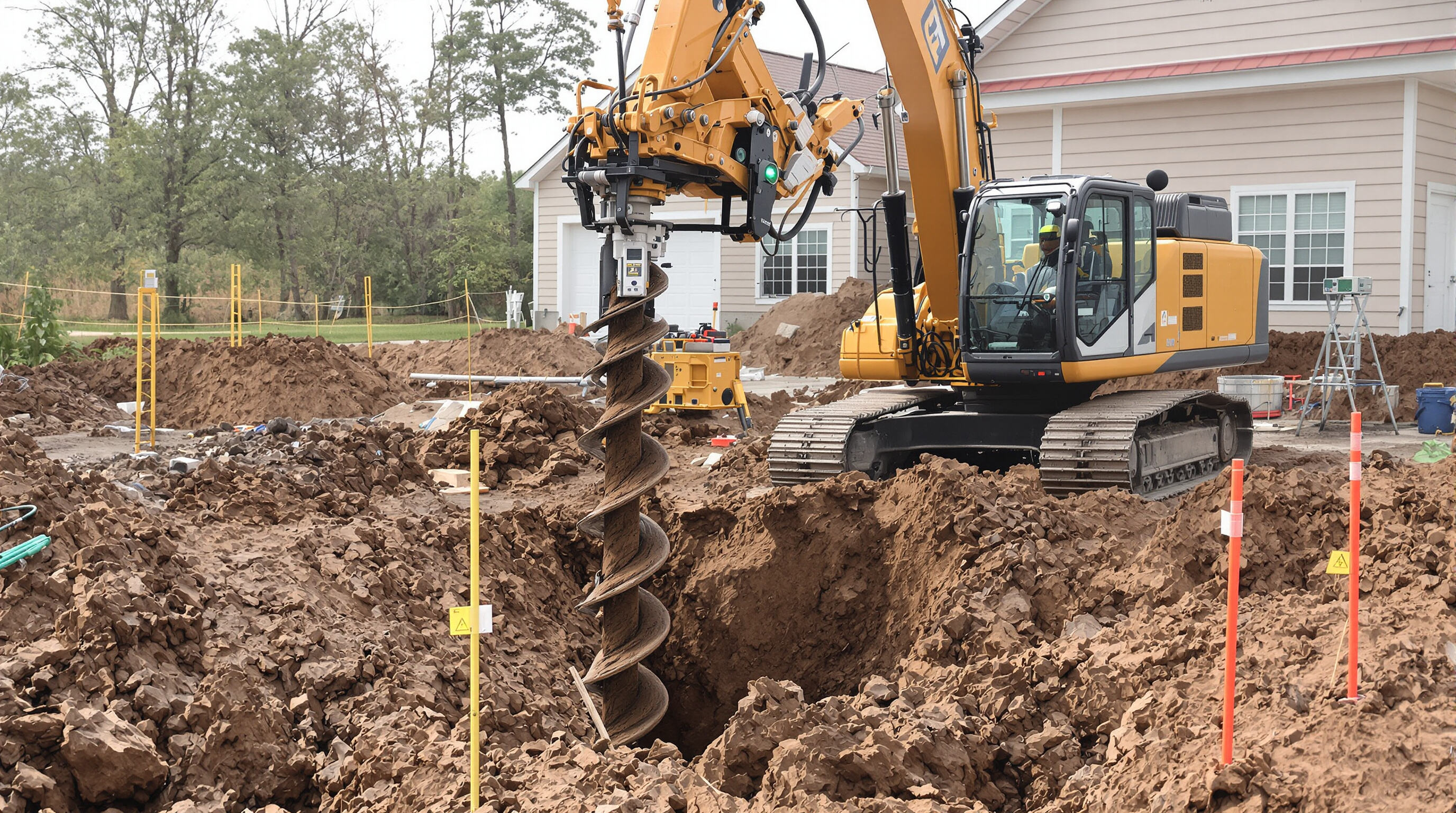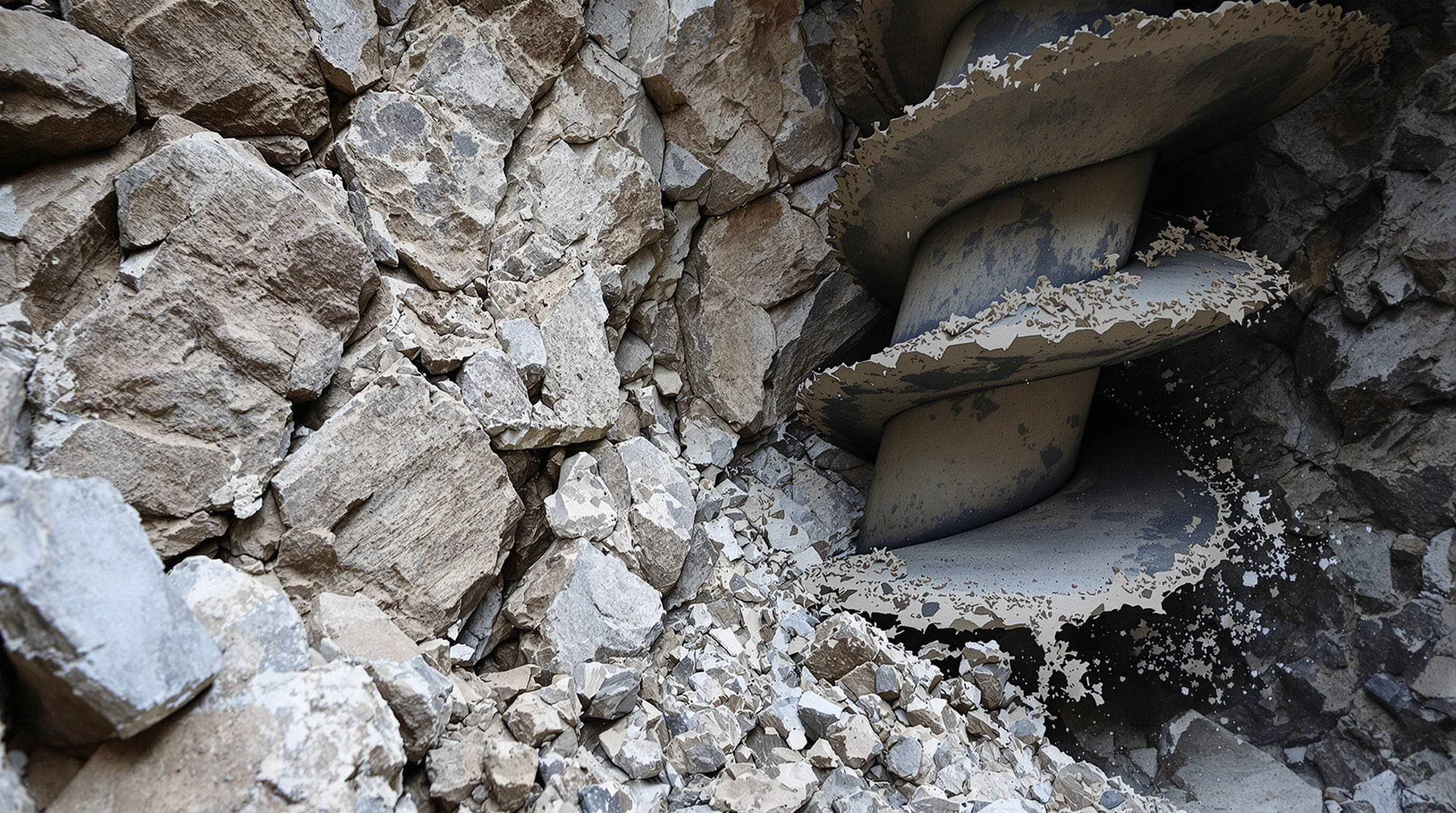Foundation Drilling with Excavator Augers for Precision Construction

Why Precision Matters in Shallow Foundation Work
For shallow foundation work, keeping things aligned matters a lot. Most specs call for no more than half an inch off course to keep the whole structure stable when weight gets distributed through those load bearing parts. The latest numbers from the 2024 Foundation Drilling Report show something interesting too. Around 8 out of 10 contractors have swapped their old manual digging techniques for excavator augers these days. Why? Because getting that ISO approved straightness right in both clay and sand based soils just works better with machines. And this change makes a real difference on home building sites. Contractors report cutting down on fixing mistakes by nearly 40 percent since soil conditions can be so unpredictable in residential areas, affecting how well everything holds up over time.
How Hydraulic Excavator Auger Attachments Enhance Drilling Accuracy
Modern hydraulic systems can adjust torque on the fly depending on what kind of soil they're dealing with. This means no more over drilling through soft spots and less bouncing around in tighter, stickier ground conditions. The pilot guided augers come equipped with lasers for straight line digging, getting within about 0.1 degrees vertically. That kind of precision really matters when there are pipes and cables just below the surface. Plus these attachments cut down on side to side shaking, so nearby buildings stay intact even during tricky city renovations or delicate construction projects where every inch counts.
Matching Auger Size to Hole Depth and Diameter Requirements
| Parameter | Optimal Auger Selection |
|---|---|
| Depth ≥ 6 ft | Standard flight augers with 12–24" diameters |
| Depth 6–15 ft | Extension augers with carbide-tipped cutting edges |
| Rocky substrates | Rock augers with 3-stage helix designs |
Mismatched augers contribute to 29% of foundation delays, often due to oversized bits causing collapse or undersized tools requiring multiple passes. Always align auger selection with soil analysis and blueprint specifications to ensure efficiency and precision.
Efficient Tree and Post Hole Digging in Landscaping Projects
Meeting Urban Landscaping Demands with Rapid Hole Excavation
Getting landscaping done right in busy city areas takes both speed and accuracy, particularly when there are so many projects crammed into tight timelines. With excavator augers, workers can punch out around 8 to 12 post holes every hour even in tough compacted soil conditions. That's roughly three times quicker than digging by hand according to GreenScape Journal from last year. The time savings really matters during park makeovers, setting up new tree grids, or installing fences for businesses. A single day's delay on these kinds of jobs often means thousands extra in costs down the line for contractors.
Benefits of Using Excavator Auger Attachments for Repetitive Tasks
Hydraulic auger systems help cut down on operator tiredness and keep holes pretty much the same depth, usually within half an inch or so, even when working on big planting projects. Some recent research showed that cities actually saved around $18 for each hole dug after they switched from old school digging bars to excavators fitted with augers for those playground setups. What makes these systems really handy is their quick connect feature. Crews can swap between digging mode and moving materials in less than three minutes flat, which means no downtime between tasks and keeps everything running smoothly throughout the day.
Selecting the Right Auger Bits: Carbide Teeth for Durability in Varied Soils
| Soil Type | Recommended Bit | Projected Lifespan |
|---|---|---|
| Sandy loam | Standard spiral bit | 120–150 hours |
| Rocky clay | Carbide-tipped rock bit | 80–100 hours |
| Mixed urban fill | Dual-flight carbide bit | 100–120 hours |
Carbide teeth extend bit life by 40% in abrasive soils containing construction debris, while dual-flight designs prevent clogging in moist clay. Contractors using soil-specific augers report 23% fewer bit replacements annually (2023 equipment maintenance surveys), improving uptime and cost control.
Utility and Pipeline Installation Using Excavator Augers
Supporting Underground Infrastructure Expansion in Suburban Development
When suburbs keep growing outward, excavator augers become essential tools for laying down all sorts of underground infrastructure from water mains to gas lines. These machines can dig holes ranging between six inches and forty-eight inches wide right where space is tight, which means less damage to surfaces than old fashioned trench digging methods. The hydraulic attachments let workers run new utility lines under streets and buildings already standing there without shaking up surrounding foundations too much. That makes these augers pretty much indispensable for cities trying to grow while keeping things looking nice on the surface.
Achieving Precise Conduit and Cable Placement With Multi-Purpose Augers
Multi-purpose augers combine helical flighting with carbide teeth to maintain ±1" vertical accuracy when burying electrical conduits or fiber-optic cables. This precision reduces post-installation alignment issues by 63% compared to manual digging (2023 Trenchless Technology Report). When paired with GPS-guided systems, these tools achieve millimeter-level placement accuracy for critical infrastructure projects.
Choosing Auger Diameter Based on Utility Project Specifications
| Project Type | Typical Diameter Range | Depth Capacity |
|---|---|---|
| Residential Gas Lines | 8"-12" | 10-15 ft |
| Fiber-Optic Networks | 6"-10" | 6-10 ft |
| Stormwater Drainage | 24"-48" | 15-25 ft |
Auger size selection follows pipe material flexibility and burial depth requirements outlined in ASTM F2160 standards. For reinforced concrete culverts in rocky terrain, large-diameter rock augers with hardened steel flights are essential for reliable performance.
Rock Augers for Hard Ground: Tackling Challenging Terrain

Overcoming Drilling Difficulties in Rocky and Mountainous Sites
Regular augers have real trouble getting through broken bedrock or packed gravel, usually managing less than 12 inches of progress every minute. This slowdown can stretch out construction projects by around 35%, according to Construction Tech Review from last year. The newer rock augers tackle these problems differently. They feature stronger flighting that doesn't bend as easily when things get tough. Some models come with specially shaped carbide cutters at the tip that help absorb shocks during drilling. And the spiral design has been tweaked so it pushes away dirt and rocks about 40 percent quicker compared to what most contractors are used to seeing in standard equipment.
Advantages of Carbide-Tipped Rock Augers Over Standard Bits
| Feature | Carbide-Tipped Augers | Standard Steel Augers |
|---|---|---|
| Average Lifespan | 800–1,200 hours | 300–500 hours |
| Hardness Rating | 9.5 Mohs (tungsten carbide) | 6.5 Mohs (high-carbon steel) |
| Cost Per Linear Foot | $2.80–$3.20 | $1.50–$2.00 |
Planetary gear systems in modern excavator auger attachments enhance torque delivery, making them highly effective in demanding environments like shale deposits (Cleveland Brothers Equipment Guide). These systems distribute rotational force evenly, reducing tooth stress while maintaining drilling speeds above 18 RPM in granite.
Balancing Cost and Durability in Specialized Auger Selection
Carbide tipped rock augers definitely come with a higher price tag about 65 percent more than standard models but they pay for themselves over time especially for jobs that require drilling more than fifty holes. Experienced operators know how to make these bits last longer too. By tweaking the settings just right like slowing down rotation speed to around eighty revolutions per minute when working through tough limestone formations and keeping the downward force under two thousand five hundred pounds per square inch the lifespan of the cutting edge increases by roughly thirty percent. And let's face it most construction companies find themselves breaking even on the investment anywhere between eight to twelve months after starting work on those eighteen inch or larger diameter holes typically encountered in areas where granite is prevalent in the ground composition.
Multi-Purpose Excavator Augers for Diverse Soil Conditions
Adapting to Variable Soils in Mixed-Use and Agricultural Projects
Today's excavator augers can tackle all sorts of ground conditions, whether it's tough urban clay or soft farm soil. They work so well because operators can adjust the pitch angle and swap out different teeth depending on what they're digging through. The spiral shaped flights help keep materials from slipping away when working in sand, and those pointed edges cut through sticky clay without pushing too much dirt around. According to Construction Equipment Guide last year, these design features really make a difference. What this means for crews is that they don't have to stop and change bits constantly, which saves time and keeps productivity up throughout the job site.
| Soil Type | Auger Adaptation | Productivity Benefit |
|---|---|---|
| Sandy/loose | Tightened flight spacing | 25% less material backflow |
| Clay/heavy | Serrated cutting edges | 15% faster penetration rates |
| Rocky mixed | Reinforced carbide-tipped teeth | 50% longer bit lifespan |
How Versatile Augers Reduce Equipment Changes and Downtime
Multi-purpose auger systems eliminate 40% of typical equipment swap-outs in mixed-soil projects. Contractors using dual-mode augers report 30% fewer idle hours compared to single-bit setups (Earthmoving Technology Journal 2024). Hydraulic quick-couplers enable bit changes in under 25 seconds while maintaining full hydraulic flow to the attachment.
Emerging Trends: Smart Auger Systems With Automatic Bit Adjustment
With IoT sensors, we can analyze soil resistance as it happens, which means machines adjust their rotation speed and downforce automatically on the fly. The latest smart systems have managed to hit around 98% consistency when drilling through layered soils, while cutting what operators need to do manually by about half according to last year's Heavy Equipment Innovation Report. Looking ahead, manufacturers are talking about adding self sharpening teeth and some kind of AI that predicts wear patterns. This should help schedule maintenance better and extend how long parts last before needing replacement.
FAQ
What are the main benefits of using excavator augers for shallow foundation drilling?
Excavator augers provide precise alignment and reduce errors, cutting down on the need for corrective measures in unpredictable soil conditions, especially in residential areas.
How do hydraulic excavator auger attachments enhance drilling accuracy?
Hydraulic systems adjust torque based on soil type. Equipped with lasers, they ensure precise vertical drilling, minimizing disruptions during construction.
What factors should be considered when matching auger size to hole depth and diameter requirements?
Ensure auger selection aligns with soil analysis and blueprint specifications to prevent mismatches leading to foundation delays.
How do excavator augers benefit landscaping projects in urban areas?
Excavator augers increase efficiency by allowing rapid post hole excavation. They are faster and reduce fatigue compared to manual digging, minimizing project delays.
What is the advantage of using carbide-tipped rock augers for challenging terrain?
Carbide-tipped rock augers have longer lifespans and higher hardness ratings, making them more efficient and durable for drilling in hard ground conditions.
What emerging technologies are influencing excavator auger performance?
Smart auger systems equipped with IoT sensors adjust on-the-fly for varied soil resistance, enhancing drilling consistency and reducing manual input.
Table of Contents
- Foundation Drilling with Excavator Augers for Precision Construction
- Efficient Tree and Post Hole Digging in Landscaping Projects
- Utility and Pipeline Installation Using Excavator Augers
- Rock Augers for Hard Ground: Tackling Challenging Terrain
- Multi-Purpose Excavator Augers for Diverse Soil Conditions
-
FAQ
- What are the main benefits of using excavator augers for shallow foundation drilling?
- How do hydraulic excavator auger attachments enhance drilling accuracy?
- What factors should be considered when matching auger size to hole depth and diameter requirements?
- How do excavator augers benefit landscaping projects in urban areas?
- What is the advantage of using carbide-tipped rock augers for challenging terrain?
- What emerging technologies are influencing excavator auger performance?


